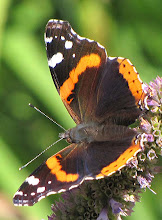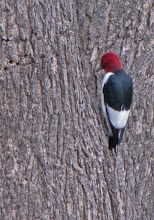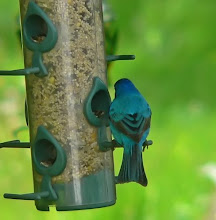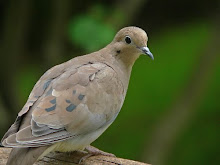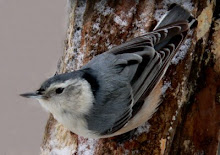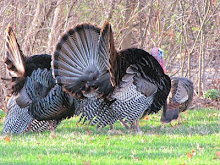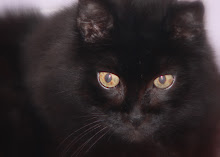 Goldfinches are one of the loveliest of our native birds. They are also one of the easiest to attract to your backyard.
Goldfinches are one of the loveliest of our native birds. They are also one of the easiest to attract to your backyard. In the late summer, goldfinches begin nesting and raising their young. One of the reasons they wait until so late in the season is because they use thistle down to line their nests and they feed their babies thistle seed. If you provide an easily accessible Nyjer thistle feeder sock, it will bring goldfinches into your garden. When the young are learning to fly, the parents will bring them to the thistle sock and teach them to eat on their own. This is one of the most rewarding times to sit back and enjoy wild birds outside your window.
Two weeks ago I had one thistle sock hanging outside my dining room window. The birds would empty it every two or three days. Now I have three socks and there are 4 or 5 finches on each sock all day long. Hungry finches are a rowdy, noisy crowd and their squabbling, and constant movement is an endless source of interest for both me and the house cats.
Most of the finch group is this season’s fledglings. At first they sit on a branch and loudly demand “Feedme me, feedme, feedme”. After a few minutes of watching the older birds they jump down onto a sock and get the hang of pulling the tiny seed thru the holes.
Nyjer seed is irradiated so it will not sprout in your yard and produce a crop of thistles. The seed that falls on the ground is quickly eaten by doves and other birds. Tips for buying, feeding and storing Nyjer thistle seed: Because it is expensive, you don’t want to waste the stuff, so here is what works best for me. I by a quality brand, usually Kaytee. It isn’t the most expensive but all Kaytee brand seed is excellent quality. Wild Birds Unltd also has good seed as do many independent stores. Nyjer is usually packaged in socks for easy feeding and in vacuumed sealed bags to save a little money. The birds seem to prefer eating from socks. (I used to fill thistle tube feeders and ended up throwing away a lot of uneaten seed. For whatever reason, goldfinches in my area just don’t like the thistle tubes.) I buy several socks pre-filled with seed and when they are empty it’s easy to wash the sock and refill from a 3- or 7- pound bag. Be sure to store the opened bag in a big airtight ziplock. Nyjer gets stale after opening and the finches will often refuse it once they decide it has been opened too long.
Tips for buying, feeding and storing Nyjer thistle seed: Because it is expensive, you don’t want to waste the stuff, so here is what works best for me. I by a quality brand, usually Kaytee. It isn’t the most expensive but all Kaytee brand seed is excellent quality. Wild Birds Unltd also has good seed as do many independent stores. Nyjer is usually packaged in socks for easy feeding and in vacuumed sealed bags to save a little money. The birds seem to prefer eating from socks. (I used to fill thistle tube feeders and ended up throwing away a lot of uneaten seed. For whatever reason, goldfinches in my area just don’t like the thistle tubes.) I buy several socks pre-filled with seed and when they are empty it’s easy to wash the sock and refill from a 3- or 7- pound bag. Be sure to store the opened bag in a big airtight ziplock. Nyjer gets stale after opening and the finches will often refuse it once they decide it has been opened too long.
 Many other bird varieties will also visit your sock to eat Nyjer including, purple finches, house finches, redpolls, indigo buntings, chickadees, and pine siskins.
Many other bird varieties will also visit your sock to eat Nyjer including, purple finches, house finches, redpolls, indigo buntings, chickadees, and pine siskins.And one other thing. A reminder to everyone who grows coneflowers, don’t be in a hurry to deadhead or tidy up the plants after bloom. Many native birds including finches, eat the seeds of this plant. Leave the dried stems standing until the birds have eaten the seed from the cones.







